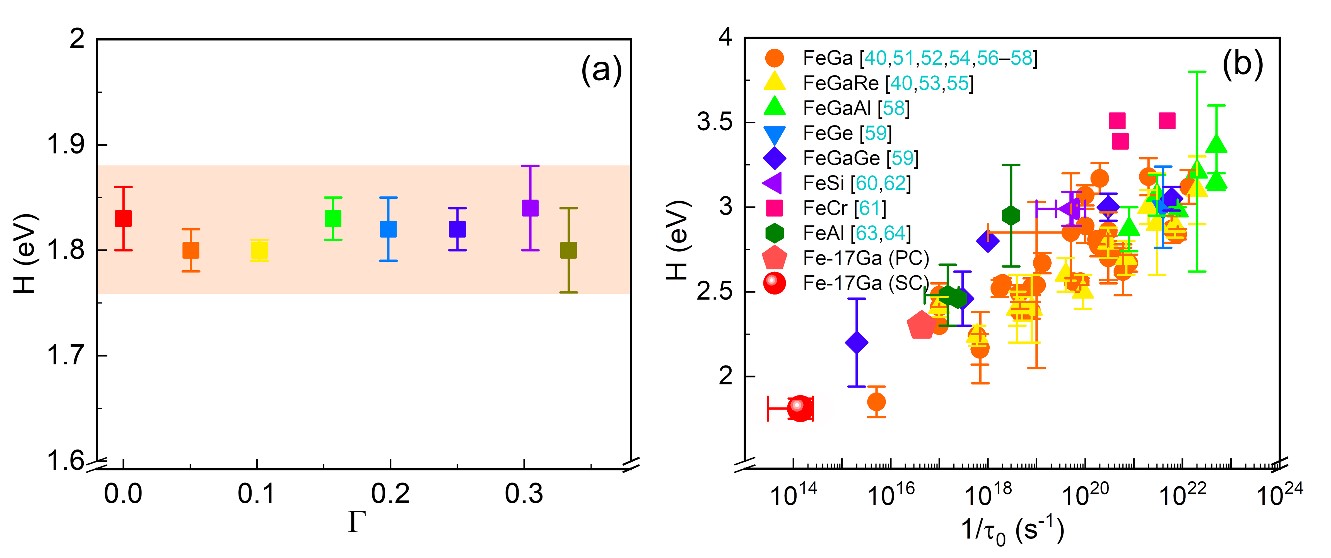
The stress-induced reorientation of the low-symmetry defects due to substitution atom pairs can give rise to an internal friction peak, Zener relaxation. It is one of the most representative point defect relaxations in metal.
Recently, researchers from the Institute of Solid State Physics, Hefei Institutes of physical science of Chinese Academy of Sciences revealed the Zener relaxation in the body-centered cubic (BCC) Fe-Ga single crystals against intuition originates primarily from the stress-induced reorientation of the second-nearest-neighbor Ga-Ga atom pairs.
The relevant result was published in Acta Materialia.
Fe-Ga alloys have great potential for application in the field of actuators, sensors, and micro-vibration suppression. However, the magnetostriction and damping capacity of Fe-Ga alloys are closely related to the occupation of Ga atoms, so identifying and evaluating Ga atom occupation has become a major challenge in Fe-Ga alloy research. The internal friction (IF) technique is sensitive to internal defect relaxation, so it is expected to solve this problem of evaluating Ga atom occupation by the IF technique and provide guidance for improving Fe-Ga alloy properties.
In this study, the team successfully grew large-sized FeGa single crystals and prepared FeGa binary single-crystal alloys with different orientation factors. A comparative study of the IF behavior of FeGa polycrystals and single crystals confirmed that the relaxation peak near 450°C originated from Zener relaxation behavior within the grains. It was observed that the net peak height of Zener relaxation increased with the orientation factor of the single crystals.
Further analysis revealed that the relaxation strengths of BCC cells with different atom-pair configurations varied. Trigonal and orthorhombic configurations exhibited decreased relaxation strengths with increased orientation factors, while tetragonal configuration showed the opposite trend. Zener relaxation in BCC-structured FeGa single crystals primarily originated from the contribution of second nearest-neighbor solute-atom pairs, rather than first nearest-neighbor pairs as previously believed. The relaxation activation energy for Fe-17at.% Ga single crystals was found to be around 1.8 eV, lower than that measured in polycrystalline materials.
Additionally, a positive correlation between Zener relaxation strength and the magnetostriction coefficient was established through electronic structure and strain analysis.
This research corrects the understanding of Zener relaxation in BCC alloys, applicable to other BCC solid solution alloys. Moreover, it demonstrates the potential of Zener experiments in analyzing solute ordering, ordering degree, and solute atom occupancy in various alloys.

Fig. 1. (a) Net Zener relaxation IF peaks of Fe-17at.%Ga single crystals with different orientations; (b) Relaxation strength as a function of the orientation factor. (Image by SUN Meng)

Fig. 2. (a) Variation of Zener relaxation activation energy with the orientation factor for original samples with different orientations; (b) Comparison of activation energy and pre-exponential factor of Zener relaxation in different BCC-structured Fe-based alloys. (Image by SUN Meng)